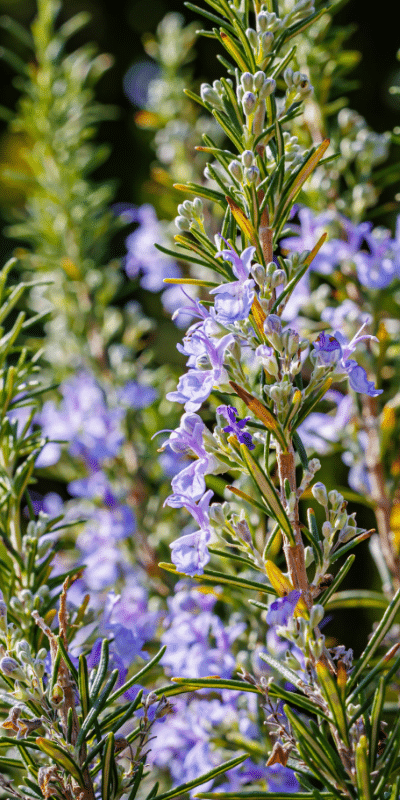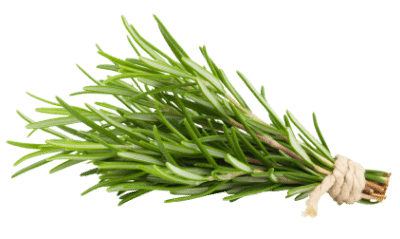
Health
benefits
Rosemary has a long history and has been used in many ceremonies: for weddings as a symbol of love and fidelity, during epidemics to purify the air, or even to chase away evil spirits… But what are its real attributes?
Health benefit claims can be based on the traditional use of the plants and plant extracts. But you need to be able to prove the benefits you claim. The good news for rosemary is that its health benefits are well documented.
Fresh rosemary is rich in fibre (it contains no less than 14 grams per 100 grams) and is also an excellent source of minerals, such as calcium, iron and magnesium.
- Rosemary is rich in calcium (317 mg/100 g), which contributes to healthy muscle function and good skin.
- It is rich in iron (6.65 mg/100 g), which helps to maintain normal cognitive function and a healthy immune system.
- It is rich in magnesium (91 mg/100 g), which helps to reduce fatigue, keep muscles working properly and maintain good bone structure.
Nutritional
values
The right time
to eat it
Rosemary can be harvested all year round, but its flavour is most intense when it flowers in spring.
Vegetable garden
or city balcony
Rosemary, or Rosmarinus officinalis, is a member of the Lamiaceae family. It grows into a small bush that can reach a height of 1 to 1.5 metres. It likes full sunshine, fairly light soil, and good drainage. Its biggest enemy? Damp! On the other hand, it is very tolerant of drought.
Its stems are green and branched, and have stiff, needle-like evergreen leaves.
Rosemary can be planted in the spring, from April to June, or in autumn, preferably under cover, in light, well-drained soil. When the plant is well established and around 5cm tall, it can be planted out in full sun. To look after the plant, you just need to help it grow.
Choosing
and storing
Rosemary is used in the kitchen both fresh and dried. Dried rosemary retains its flavour and can be stored for up to a year. Its taste is strongest when it flowers in spring, but it can be harvested all year round.
After harvesting, simply rinse the stems and dry them on kitchen paper. Fresh rosemary is best used as soon as possible after it is picked.
It can be stored in a container in the fridge for up to a couple of weeks.
There are two ways of drying aromatic herbs: the longer method, but which preserves maximum flavour, aroma and nutrients, is simply to air-dry it in the sun. You can also oven-dry it at 50°C with the door open.
Tips
and tricks
Rosemary is traditionally used to add flavour to grilled meats and roasts. Think rack of lamb, roast pork and even game. It enhances many sauces and is often used in dishes with a touch of honey.
It’s also delicious with salmon, potatoes or sautéed mushrooms. You can even use rosemary in a Camembert fondue or in dessert recipes, such as biscuits.
There are plenty of ways to make sure you never waste a sprig of rosemary. Have you ever thought of making your own rosemary-flavoured oils? Or why not make a rosemary-flavoured jam? Our favourite combinations are apricot and rosemary, Mirabelle plum and rosemary jam, melon and rosemary, or peach and rosemary jam. Rosemary pairs extremely well with these different fruits. And not only in jam, but also in fruit puddings, braised fruit, ice creams, etc. Stocks, soups, roasted vegetables… don’t forget to throw in your aromatic herbs instead of wasting them!
What is the environmental
impact of rosemary?
We can find out more from its PEF (Product Environmental Footprint) score! Established by Agribalyse*, the score takes into account every stage in a vegetable’s life cycle: how it’s cultivated, the impact of processing and transport, etc. The lower the score, the less impact it has on the environment.
- Fresh rosemary: 0.13
- Dried rosemary: 0.4
- Raw beef steak: 2.77
*Figures drawn from the Agribalyse database, which calculates the environmental score of different types of food. This unique score is a weighted average of 16 indicators, calculated according to the European PEF methodology. It does not correspond to an environmental label or ‘eco-score’
CO2 equivalent: for 100g of fresh rosemary, 0.081kg of CO2 eq, or as much as from 2.4 g of raw beef steak.

Can everyone eat it?
Rosemary has a strong flavour which may not appeal to young children. Start off by trying rosemary in small quantities, for example in a pumpkin risotto or in pureed Jerusalem artichokes.
Rosemary is one of the most widely used and enjoyed aromatic herbs. Use it to flavour oil or vinegar, or add it to the cooking water of your potatoes! To add an irresistible touch to your barbecues, just sprinkle some rosemary on the charcoal.
Where does it come from?
The origins and varieties of rosemary
Rosemary is native to the Mediterranean region. It adapts easily to various habitats and is now found all over Europe. It is more susceptible to excessive humidity than to cold. There are many varieties of rosemary, including:
- Rosmarinus officinalis, the standard variety
- Rosmarinus officinalis ‘Roseus’, with pale pink flowers
- Rosmarinus officinalis var. Albiflorus, with white flowers
- Rosmarinus officinalis ‘Aureus’, with yellow variegated leaves



 Dandelion greens
Dandelion greens  Sorrel
Sorrel  Plant a Fast-Growing, Natural Vegetable Patch
Plant a Fast-Growing, Natural Vegetable Patch 









